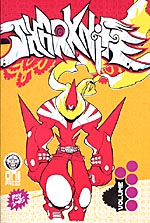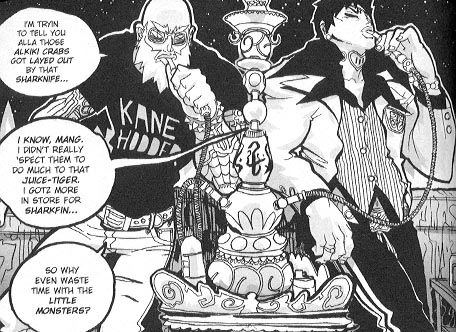 By Corey Sutherland Lewis the Rey
By Corey Sutherland Lewis the Rey
136 pages, black and white
Published by Oni Press
More and more often, publishers and fans seem to be pushing anything published in a digest-sized format as manga. On a technical level, that’s either completely true or utterly ludicrous, since it’s just the Japanese word for “comics” so you can either say that all comics are manga (since they’re the same word) or that only Japanese comics can be manga. The reality of the situation, though, is that “manga” as a word seems to be changing in English, to instead be used as a classification for a certain style and sensibility of comics. The reason why I bring all of this up is that just last week while looking through the latest releases, I saw two kids talking about Sharknife. “Check out this new manga,” one of them was saying to the other, eagerly flipping through it. Is Sharknife manga? While they do share some influences, I don’t think it’s an entirely accurate description, but that’s perhaps because it’s very difficult to pigeonhole Sharknife into anything but its own unique entity.
At the Guangdong Factory, things are always bound to be interesting. Not only do they produce more delicious peach dumplings than any other restaurant, but its walls are packed full of evil monsters courtesy the gangster Ombra Ravenga. Fortunately for Guangdong, they’ve got a secret weapon to stop the monsters that erupt from the walls: Sharknife!

When I first started reading Sharknife, Corey Sutherland Lewis the Rey didn’t remind me so much of manga, but rather of another North American artist (although one who did work for manga giant Kodansha for years): Paul Pope. At first I thought it was Chieko’s opening narration that reminded of Pope’s comics (being of the same sensibility as the opening to THB #6a) but it’s more than that. I think it’s the sense of frantic fun that suffices both THB and Sharknife that connects the two; you always get the sense that, be it the Martian cities of THB or the nameless town of Sharknife, it’s a real place and exciting to visit. That’s not the only appeal of Sharknife, though.  There are a lot of crazy, larger-than-life ideas that suffuse the book, from eating fortune cookies to transform into Sharknife, to the idea of someone using machines and gigantic hypodermic needles to literally pump the walls of a restaurant full of monsters. Even the restaurant itself is literally larger than life, five stories tall and boasting a production of food per day that other ones don’t accomplish in a year. The one downside to Sharknife‘s writing, though, is that it’s already getting repetitious and it’s only the first volume of this new series. There’s a distinct pattern forming: attack, transform, fight, defeat, flirt. By the end of the book, I found myself a little bored with the progression of events, something that shouldn’t be happening in a book this crazy and energetic. Future volumes are going to need to find something more to happen than the latest monster of the week bursting out of the Guangdong Factory wall and Sharknife defeating it, or I can’t see Sharknife sustaining an audience.
There are a lot of crazy, larger-than-life ideas that suffuse the book, from eating fortune cookies to transform into Sharknife, to the idea of someone using machines and gigantic hypodermic needles to literally pump the walls of a restaurant full of monsters. Even the restaurant itself is literally larger than life, five stories tall and boasting a production of food per day that other ones don’t accomplish in a year. The one downside to Sharknife‘s writing, though, is that it’s already getting repetitious and it’s only the first volume of this new series. There’s a distinct pattern forming: attack, transform, fight, defeat, flirt. By the end of the book, I found myself a little bored with the progression of events, something that shouldn’t be happening in a book this crazy and energetic. Future volumes are going to need to find something more to happen than the latest monster of the week bursting out of the Guangdong Factory wall and Sharknife defeating it, or I can’t see Sharknife sustaining an audience.
Lewis’s art matches his writing: larger than life and full of crazy energy. It reminds me almost of graffiti murals, with the bubble-like designs and figures that overlap one another. In many ways, Lewis’s strength and weakness is the same thing, the fight scenes that dominate Sharknife. He does a good job of having his characters leap and explode across the page; in many ways this is one of the best comics I’ve ever seen when it comes to depicting motion. You can practically see them moving inside the panels, and it helps really set the mood for the rest of the book. On the down side, though, it’s sometimes hard to figure out what’s going on; even though Lewis is careful to always give an outline to his main characters to help set them apart from everything else crammed into the panel, there’s still often too much going on for one to process. It’s a little confusing on some pages, and it borders on the overwhelming.
Sharknife is ultimately like no other book on the market. It seems to absorb a little bit of everything it can get its hands on (Pope, graffiti, manga) but then synthesized them all into a single form like nothing else. There are some flaws that I hope to see worked out in later volumes, but the reason why I want to see them worked out is because the parts that do work are thoroughly enjoyable. There’s a lot of good stuff in here, and I’m really curious to see what Lewis does next.
Purchase Links:
